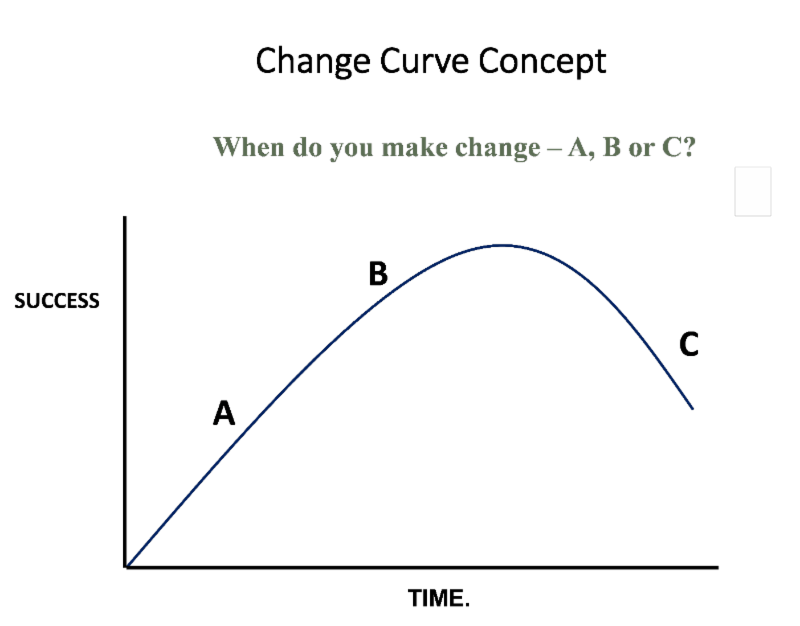By, Steve Finkelstein – Senior Partner
“The brutal fact is that about 70% of all change initiatives fail.“
Harvard Business Review
Change is often desirable, necessary or even vital in business. But why do so many change initiatives fail?
This article will help organizations better understand Change and how to manage Change effectively, to be proactive versus reactive. The following are the key concepts and tools.
First, consider when most businesses change. Do they change when they have to, or before they have to? Look at the chart below – at what point do most people make change – Point A, B or C?

“Good is the enemy of Great” is a key concept from the book Good to Great by Jim Collins, which explains why most people do not make changes at point B. Why change when we are doing well? Most change occurs at point C. When do you change the battery in your car? When do most people change jobs, careers? When do most men go to the doctor? The answer – when they have to.
When people change only when they are forced to change, they have less time, fewer resources and higher risks. Looking to the future and planning ahead increases the likelihood of success.
Second, consider the questions that team members will have about change:
The Seven Wonders of Change
- Why are we changing? What’s the business case?
- What is the degree of change?
- What is our readiness for the change?
- What will the future state look like and when?
- Who will be impacted by the change and how?
- When will the change start and how fast will we change?
- How will I be impacted by the change? (What’s in it for me?)
Third, understand the major reasons why Change Initiatives fail so you can put preventive actions in place. Do any of the following sound familiar?
- Lack of Senior Leadership Support – walk the talk
- Lack of Middle Management Support
- Lack of a Clear, Compelling Vision
- Change Takes Too Long
- Lack of the Right Resources
- Ineffective Communication
- Different Agendas
- Focus on Systems/Processes, Not People
- Lack of Stakeholder Understanding
- Poor Planning
- Lack of Commitment and Accountability
- Lack of Trust
- Lack of Disciplined Execution
- Not Ready for Change
Fourth, so what is the best change management process? Of the many different approaches we find Kotter’s 8 Step Process the most effective and easiest to execute
Fifth, so how do you understand the impacts of change? Conduct an Impact Analysis to determine what is changing and who will be impacted. See the format below.
Area of Change
New Accounting System
Who is Impacted?
Accountants
End-Users
How Are They Impacted?
New Processes, New System, Replace Excel Spreadsheets
New Reporting Formats and Capabilities, Replace Excel Spreadsheets
Actions Required
Schedule and Provide Training
Schedule and Provide Training
Sixth, once you identify the different people and organizations that will be impacted you can develop a communication matrix that lays out:
- What do we need to communicate? What is the message, the content?
- Why do we need to communicate this? Why is this important?
- Who do we need to communicate this to? Who are the people or organizations?
- When do we need to communicate? What is the timing?
- How do we need to communicate? What medium?
In summary, Change is often necessary and always challenging. If you are considering “Change” in your organization, consider using the services of an experienced, impartial objective consultant for help in avoiding pitfalls and staying on track during this pivotal time period.
